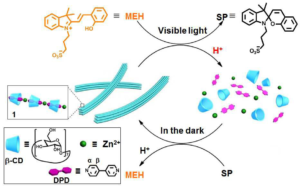Written by Tianyu Liu, University of California, Santa Cruz
Supramolecular smart materials are a family of materials composed of several molecules. They have the ability to change their configurations in response to external stimuli such as the presence of enzymes, light irradiation, and changes in pH. This property can be manipulated for a variety of applications including drug delivery and tissue engineering.
In recent years, pH-responsive supramolecular smart materials have been intensively investigated due to the simplicity of pH alteration. However, adjusting pH can have undesired consequences. First, chemical species other than the supramolecular materials (e.g., acid and base) are needed for tuning pH. The involvement of external reagents hinders the readiness of operation. Additionally, the use of acid and base inevitably introduces waste products, which could eventually suppress the stimulus-response activity of the smart materials. Therefore, developing alternative ways to initiate the configuration modification of the supramolecular smart materials is highly desirable.
In a recent ChemComm. publication, Professor Heng-Yi Zhang, Professor Yu Liu and coworkers from Nankai University, China have developed supramolecular smart nanorods consisting of β-cyclodextrin (β-CD) and 4,4’-bipyridine-coordinated zinc ions. In the presence of protonated merocyanine (MEH) in water, the nanorods are able to dissociate upon visible light illumination and reconstruct themselves when placed in the dark (Figure above).
The method by which these structures can reconfigure involves a light-driven proton transfer process (Figure below). MEH molecules absorb energy from visible light and subsequently release their protons to the surroundings. These free protons then combine with the 4,4’-bipyridine (DPD). The protonated DPD molecules lose their coordination ability and disassemble with zinc ions. As a result, the entire nanorod structure collapses. When no light is present, the aforementioned proton transfer process is reversed and the nanorods are reformed. Such a process is highly reversible with no observable light-responsive activity loss for at least five cycles.
The demonstrated light-responsive supramolecular nanorods enable facile operations with no additional chemicals. This technology opens up endless new opportunities in remote control of light-responsive processes.
To find out more please see:
Light-controlled reversible self-assembly of nanorod suprastructures
Jie Guo, Heng-Yi Zhang, Yan Zhou and Yu Liu
DOI:10.1039/C7CC03280C












